Volume or Intensity? A Systematic Review and Meta-Regression of How Exercise Influences Mitochondrial Content, Capillarization, and Aerobic Capacity
Mitochondrial Content Increases Across Intensities: Mitochondrial biogenesis rose by roughly 23% with endurance training, 27% with high-intensity training, and 27% with sprint interval training.
Training Efficiency for Mitochondrial Gains: When normalized per hour, sprint interval training was ~2–3 times more efficient than high-intensity and endurance protocols in boosting mitochondrial content, especially for less-trained individuals.
VO₂ Max Gains in All Modalities: Participants improved VO₂ max by about 9–12% regardless of training intensity, but sprint interval training provided the highest gains per minute of exercise.
Capillarization Favors Endurance Work: Although all exercise modes elevated the capillary-to-fiber ratio, endurance training produced the most substantial increase in capillary density—5–10% higher than high-intensity or sprint protocols.
Importance of Baseline Fitness: Untrained and moderately trained participants showed more pronounced gains in mitochondrial content, VO₂ max, and capillarization compared to well-trained individuals, reflecting the principle of diminishing returns at higher fitness levels.
Minimal Influence of Age, Sex, and Disease Status: While baseline fitness was the strongest predictor of adaptation magnitude, the authors found no significant detrimental impact of age, sex, or disease status on the ability to improve mitochondrial content, capillarization, or VO₂ max with exercise.
Introduction
If one truth has stood the test of time in exercise science, it’s this: our muscles are remarkably adaptable. As early as 1939, Olga Chepinoga demonstrated that regular bouts of exercise could spark the growth of new mitochondria inside muscle cells. Decades later, Per Andersen showed that exercise also expands the tiny blood vessels (capillaries) delivering oxygen and nutrients to our working muscles. Since those early breakthroughs, countless studies have confirmed that mitochondria and capillaries lie at the heart of our capacity to perform work and maintain metabolic health. Yet, a fundamental question remains: Which training variables—volume or intensity—most powerfully drive these adaptations?
Mitochondria, aptly called the “powerhouses” of the cell, produce the ATP needed for nearly every energy-demanding process in the body. Increases in mitochondrial content can elevate endurance performance and promote long-term metabolic health, helping stave off chronic diseases. Meanwhile, capillarization—the increase in tiny blood vessels surrounding each muscle fiber—improves oxygen delivery and removal of metabolic byproducts. It follows that training strategies that enhance both mitochondrial content and capillarization tend to deliver robust gains in aerobic performance and overall vitality. But the “how” and “how much” remain a matter of debate.
Some argue that high-intensity methods are best for jump-starting rapid improvements in mitochondrial function; others counter that longer, lower-intensity “zone 2” workouts cultivate a denser capillary network and yield more sustainable gains. Further complicating the picture are factors like training frequency, baseline fitness, age, and sex, which can modulate the body’s response to a given exercise dose. Parsing out these variables to prescribe the “perfect” exercise plan is no small task. While individual research studies abound, their diversity in protocols and populations makes it challenging to pinpoint universal conclusions.
A recent meta-regression analysis, titled “Effects of Exercise Training on Mitochondrial and Capillary Growth in Human Skeletal Muscle: A Systematic Review and Meta-Regression,” set out to investigate exactly these questions. Drawing on hundreds of studies and data from nearly 6,000 participants, the authors set out to answer the ongoing questions about how exercise intensity and volume—along with personal characteristics—shape mitochondrial content and capillary density in skeletal muscle. They also evaluate related measures like VO₂ max, muscle fiber size, and fiber type proportions, offering a panoramic view of how exercise sculpts our muscular and cardiovascular systems.
From revealing which training modality delivers the most benefit per minute of exercise, to probing whether age or sex alter the pathways for adaptation, the findings address longstanding debates in exercise physiology. The result is a practical, evidence-based framework that coaches, athletes, and health professionals alike can use to optimize training—whether the goal is to improve endurance performance, stave off age-related decline, or simply pursue a healthier and more active life.
Purpose and Core Variables
At its core, the review aimed to pinpoint how specific training variables—namely training volume, training intensity, and personal characteristics—shape the gains in mitochondrial content, capillary density, and VO₂ max following exercise interventions. While the goal sounds straightforward in theory, synthesizing findings across hundreds of studies is challenging because each study uses different protocols, participant demographics, and measurement techniques. By pooling this wide range of evidence, the authors sought to distill consistent, overarching trends that might not be evident from any single trial.
Training Intensity Classifications
To simplify comparisons, the authors categorized exercise protocols into three main intensity groups. These categories reflect established thresholds in exercise physiology—particularly the second ventilatory threshold and the approximate 4 mmol/L blood lactate mark, both of which are widely recognized indicators of when exercise transitions from moderate to high-intensity effort.
- Low-to-Moderate-Intensity Continuous Endurance Training. Defined as efforts below either the second ventilatory threshold, 4 mmol/L blood lactate, 87% of maximal heart rate, 87% of VO₂ max, or 75% of maximal power output (Watts). This threshold generally corresponds to intensities where aerobic metabolism predominates, allowing for relatively extended bouts of exercise.
- High-Intensity Interval or Continuous Training. Defined as efforts above the second ventilatory threshold, 4 mmol/L blood lactate, 87% of maximal heart rate, 87% of VO₂ max, or 75% of maximal power output (Watts). These intensities push the cardiovascular and metabolic systems closer to their upper limits, often eliciting higher oxygen consumption and greater recruitment of fast-twitch muscle fibers.
- Sprint Interval Training. Defined as maximal or supramaximal sprints (all-out efforts), typically lasting 4–90 seconds. These protocols provide an even more potent stimulus for explosive power and can rapidly tax both aerobic and anaerobic energy pathways within a short duration.
The Significance of Lactate Thresholds
Why 4 mmol/L lactate?
The 4 mmol/L blood lactate concentration, known colloquially as the “lactate threshold” or “onset of blood lactate accumulation (OBLA),” has historically been used as a practical benchmark for distinguishing between moderate-intensity and high-intensity exercise. Once lactate levels rise above this threshold, the body shifts toward greater anaerobic contribution, leading to faster accumulation of metabolic byproducts that can impair sustained performance if maintained for too long.
Ventilatory thresholds as complementary markers
Similarly, ventilatory thresholds (VT1 and VT2) reflect changes in breathing patterns in response to rising CO₂ levels and hydrogen ions (from lactate). The second ventilatory threshold (VT2) corresponds closely with the 4 mmol/L lactate mark for many individuals, marking a point where exercise intensity begins to feel significantly more challenging and physiologic stress increases sharply.
Why it matters
By identifying these cutoffs—whether through direct lactate measurement, breath-by-breath gas analysis, or estimated heart rate/power zones—athletes, coaches, and researchers can:
- Tailor workout intensity to target specific physiological adaptations (e.g., developing aerobic capacity vs. stressing anaerobic pathways).
- Manage training load to avoid excessive fatigue or overtraining while ensuring adequate stimulus for improvement.
- Gauge progress by seeing how lactate thresholds and ventilatory thresholds shift over time with consistent training.
Because these thresholds capture a meaningful transition in metabolic demands, they are invaluable for classifying exercise as low/moderate vs. high intensity in studies—and, practically speaking, for designing balanced training programs that address the full spectrum of aerobic and anaerobic development.
Participant Fitness Levels
Another key feature of the analysis was the classification of participants based on their baseline VO₂ max, a standard measure of aerobic capacity:
- Untrained: Baseline VO₂ max of 34.8 mL·kg⁻¹·min⁻¹
- Moderately Trained: Baseline VO₂ max of 48.8 mL·kg⁻¹·min⁻¹
- Well-Trained: Baseline VO₂ max of 62.2 mL·kg⁻¹·min⁻¹
These cutoffs mirror the general tiers in exercise physiology research. Individuals with lower baseline fitness often experience rapid, broad-spectrum adaptations to almost any consistent training, whereas well-trained individuals have already tapped into many of the “low-hanging fruit,” requiring higher-intensity or more specialized training to see further improvements.
What do these numbers mean in practice?
VO₂ max reflects how much oxygen your body can utilize per kilogram of body weight per minute during peak exertion. For someone whose VO₂ max is around 34.8, this translates to a lower threshold for fatigue and less capacity for sustained high-intensity exercise. On the other hand, individuals at 62.2 mL·kg⁻¹·min⁻¹ can perform much more demanding workouts before reaching exhaustion. Theoretically, an untrained person might notice large, rapid gains from even moderate activity, while a well-trained athlete will need more advanced protocols—like higher-intensity intervals or specialized endurance regimens—to keep moving the needle on aerobic performance.
Why Focus on Mitochondrial Content, Capillarization, and VO₂ max?
Centering this review on mitochondrial content, capillarization, and VO₂ max is rooted in a substantial body of research showing how these factors collectively underpin both exercise performance and long-term health:
1. Mitochondrial Biogenesis:
- Mitochondria generate ATP through oxidative phosphorylation, fueling muscle contractions and countless other bodily processes.
- Higher mitochondrial density typically correlates with enhanced metabolic efficiency—meaning the body can rely more on fat oxidation, maintain stable blood glucose during prolonged activity, and recover more quickly between bouts of exercise.
- From a clinical perspective, robust mitochondrial function has been linked to a lower risk of chronic diseases like type 2 diabetes, cardiovascular disease, and even certain neurodegenerative conditions.
2. Capillary Density:
- Capillaries are the final conduit for oxygen and nutrient delivery to working muscle fibers, as well as the main avenue for removing metabolic byproducts (e.g., CO₂, lactate).
- Increased capillarity enables muscles to sustain higher workloads with less fatigue, improving endurance capacity and facilitating more efficient exchange of oxygen and nutrients.
- Vascular adaptations can protect cardiovascular health by enhancing blood flow and reducing peripheral resistance, supporting both athletic performance and long-term well-being.
3. VO₂ max (Maximal Oxygen Uptake):
- Often regarded as the gold standard measure of cardiorespiratory fitness, VO₂ max reflects the upper limit of your aerobic potential—how much oxygen your body can deliver and utilize during intense exercise.
- Clinically, a higher VO₂ max has been strongly associated with reduced all-cause mortality, improved cardiac function, and a greater capacity to handle life’s physical demands.
- VO₂ max improvements often mirror underlying changes in both central factors (e.g., cardiac output) and peripheral factors (muscle mitochondrial content, capillary network).
By examining these three primary markers, the study captures a broad spectrum of physiological adaptations—ranging from molecular changes within muscle cells to systemic improvements in cardiovascular function. With such a comprehensive approach, this review is poised to offer crucial insights into how training volume, intensity, and participant characteristics converge to stimulate (or limit) these adaptations.
How Training Affects Mitochondrial Content
Mitochondrial Adaptations Across Intensities
Measurements of mitochondrial content—often done by analyzing enzymes like citrate synthase or markers of the electron transport chain—indicated substantial increases across all training intensities in the reviewed studies. Specifically, the authors reported:
- 23% increase following low- to moderate-intensity endurance training
- 27% increase following high-intensity interval or continuous training
- 27% increase following sprint interval training
These findings highlight a key insight: multiple pathways can drive mitochondrial biogenesis—whether via prolonged, steady efforts or shorter, more intense sessions. The similarity in gains across different intensities underscores how each modality imposes sufficient metabolic stress to trigger adaptation.
Possible Mechanisms
- Energetic Stress and Signaling Pathways: A central player in boosting mitochondrial content is PGC-1α (peroxisome proliferator-activated receptor gamma coactivator 1-alpha). This transcription coactivator is activated when muscle cells experience heightened energy demands, such as depleted ATP reserves and increased AMP:ATP ratios. Once activated, PGC-1α coordinates the expression of numerous genes involved in oxidative phosphorylation and the generation of new mitochondria.
- Intramuscular Calcium Flux and ROS Production: Exercise-induced changes in calcium concentrations, along with a temporary rise in reactive oxygen species (ROS), also act as cellular signals to stimulate mitochondrial biogenesis. Although ROS is often associated with oxidative damage, small, transient increases in ROS can serve a regulatory role, enhancing the body’s antioxidant systems and promoting mitochondrial remodeling.
- Intensity vs. Volume Interplay: The fact that both high-intensity intervals and continuous endurance sessions elicited comparable improvements suggests that cumulative training load—the product of intensity, duration, and frequency—ultimately governs how robustly mitochondria adapt. While high-intensity training may achieve these effects in less time, steady-state endurance training can also drive increases by generating repeated, moderate metabolic stress over longer durations.
Timeline of Mitochondrial Adaptations
Interestingly, mitochondrial content began to improve as early as 2 weeks into a training intervention. For endurance and high-intensity protocols, continued increases were observed across 2–6 weeks and again from 6–10 weeks. As shown in panel A of the original figure, endurance training seems to support gradual, ongoing mitochondrial enhancements extending out to 25 weeks. This pattern aligns with the progressive signaling stimulus of regular endurance work, where repeated bouts of moderate-intensity exercise continuously nudge the muscle cells to produce more mitochondria and fortify their oxidative capacity.
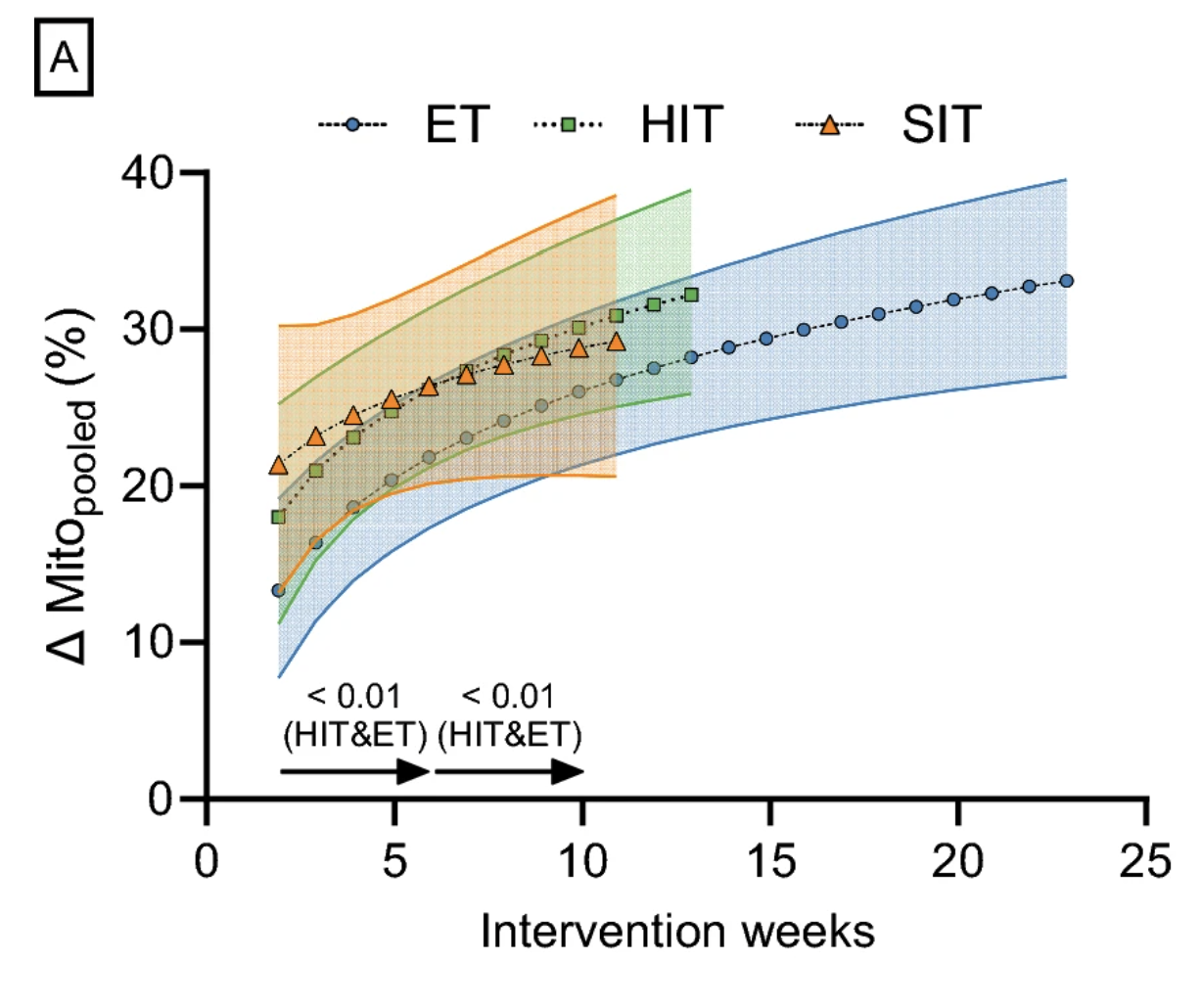
Panel A: Modeled changes in skeletal muscle mitochondrial content (ΔMitoPooled, %) over 25 weeks of endurance training (ET), high-intensity training (HIT), and sprint interval training (SIT). Significant differences between HIT and ET occur during the early (weeks 0–5) and mid (weeks 5–10) phases, highlighting distinct trajectories of mitochondrial adaptation among these training modalities.
Influence of Training Frequency
A noteworthy outcome relates to the optimal exercise frequency. Among the frequencies analyzed—2, 4, or 6 sessions per week—6 weekly sessions yielded the most robust improvements in mitochondrial content. Although a higher frequency may accelerate the signaling necessary for mitochondrial biogenesis, real-world application must consider individual recovery needs, training volume, and the risk of overuse or burnout. Nonetheless, these findings underscore that training frequency can be a powerful lever to boost the mitochondrial adaptations derived from exercise.
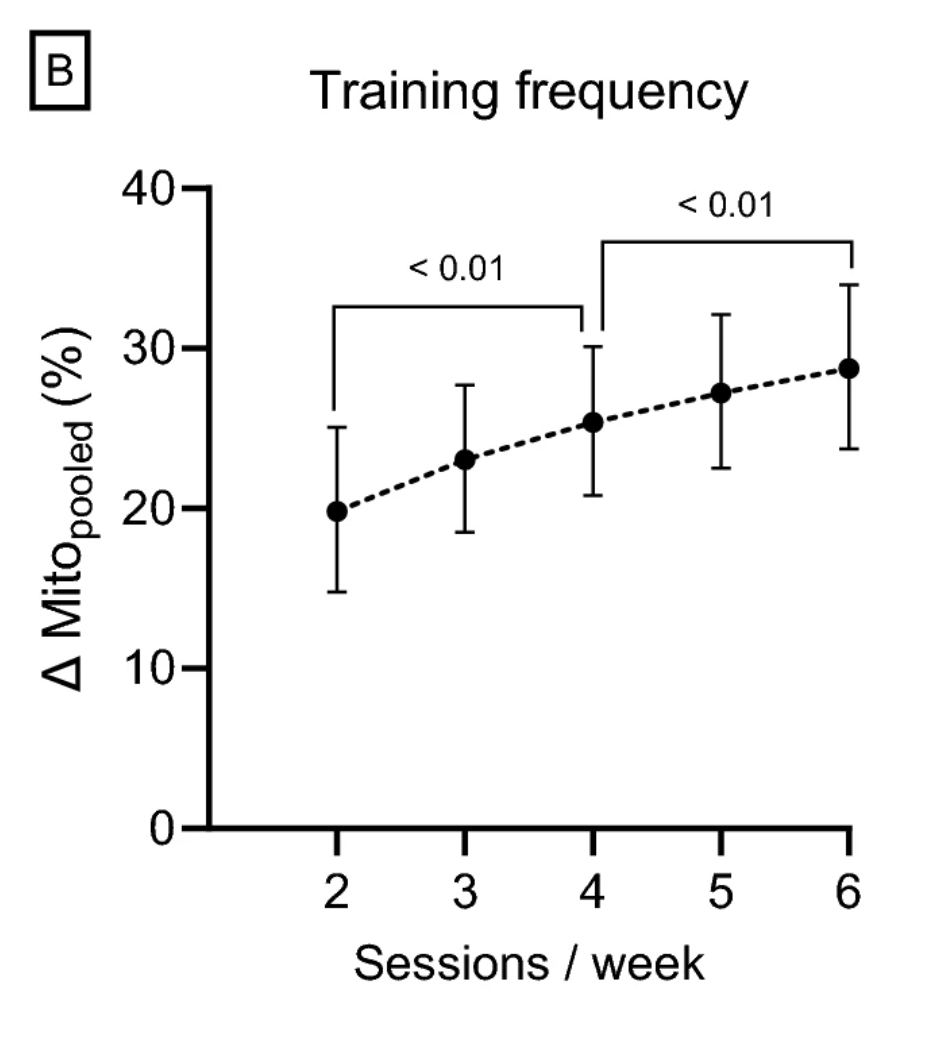
Panel B: Influence of weekly training frequency on mitochondrial content (ΔMitoPooled, %). Each data point represents the mean increase in mitochondrial markers across different session frequencies (2, 3, 4, or 6 sessions per week). Error bars denote variability among participants, and p-values (< 0.01) indicate significant differences between lower- and higher-frequency groups, demonstrating that more frequent training sessions yield greater mitochondrial adaptation.
Fitness Level Matters
Mitochondrial improvements were observed across the entire fitness spectrum—untrained, moderately trained, and well-trained individuals all benefited significantly. However, the magnitude of improvement followed a clear gradient:
- Moderately trained participants improved by about 15% more than well-trained individuals.
- Untrained participants experienced ~6% greater improvements than moderately trained participants.
Put another way, the lower your starting point, the larger the relative gain (panel C). This finding reflects a foundational principle in exercise physiology: diminishing returns. Novices have more “room to grow” and often see the greatest proportional gains, whereas highly trained individuals may need a more specialized or intense stimulus to nudge mitochondrial content further.
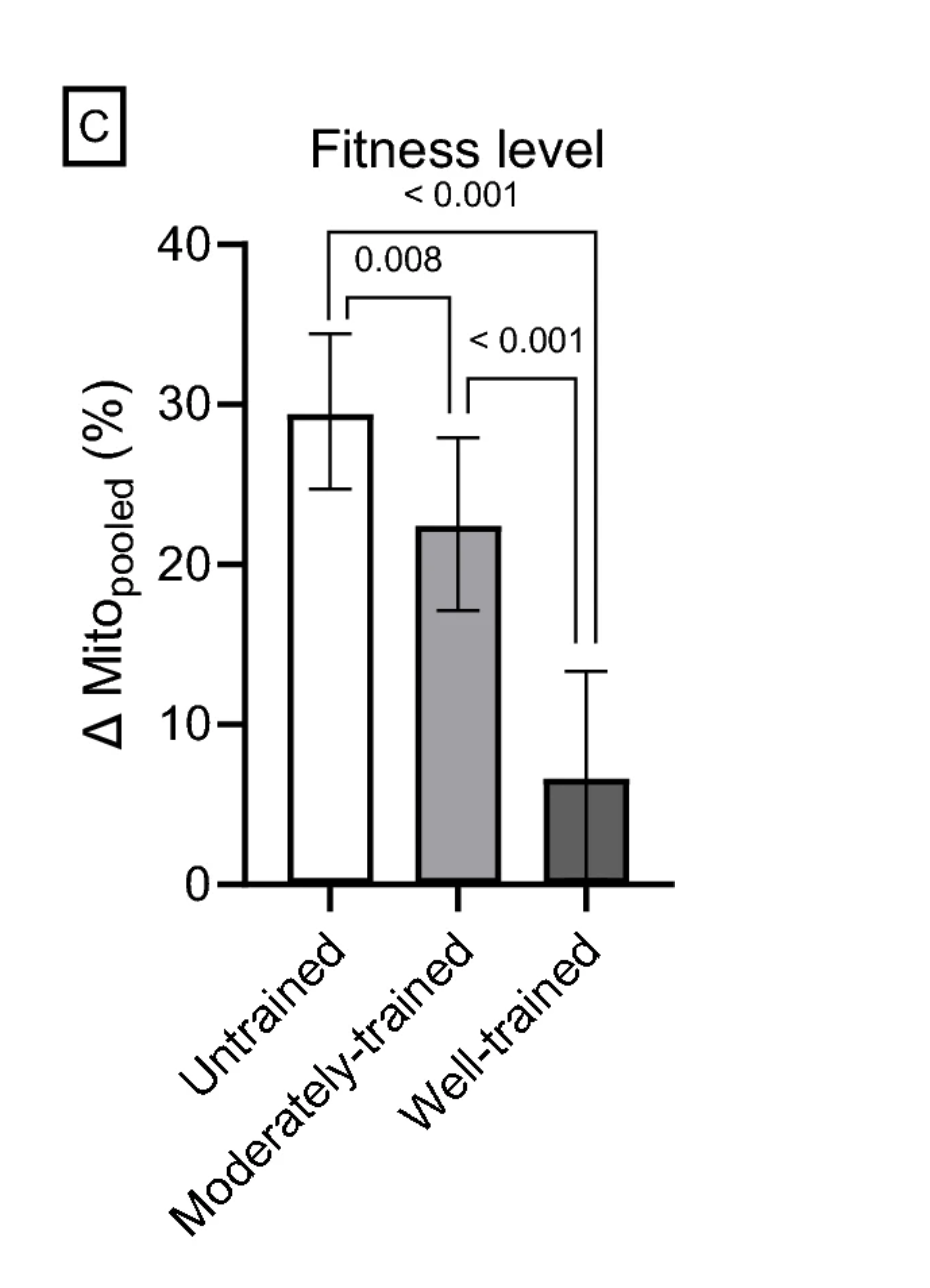
Panel C: Effect of baseline fitness level on exercise-induced changes in mitochondrial content (ΔMitoPooled, %). Bars represent the mean percentage increase for untrained, moderately trained, and well-trained participants highlighting significant differences between each fitness category, illustrating that individuals with lower initial fitness achieve larger proportional gains in mitochondrial adaptations following training.
No Significant Effect of Age, Sex, or Disease Status
Although certain health conditions and demographic variables can affect exercise adaptations in specific contexts, the authors found that age, sex, and disease status did not significantly alter mitochondrial responses (panels E, F, and G). These results imply a broad applicability of aerobic training for improving mitochondrial function. Whether you’re older, younger, male, female, healthy, or managing a chronic condition, well-designed endurance or interval programs can still induce meaningful gains in the cellular “powerhouses” of your muscle cells.

Influence of disease status (E), sex (F), and age (G) on exercise-induced changes in mitochondrial content (ΔMitoPooled, %). Bars show the mean percentage increase in mitochondrial markers, with error bars representing variability across studies. The non-significant p-values (0.714, 0.478, and 0.654, respectively) indicate that neither disease status, sex, nor age significantly alters the overall magnitude of mitochondrial adaptations, suggesting a broad applicability of training-induced benefits across different demographic and health profiles.
Change in Mitochondrial Content Per Hour of Exercise (Training Efficiency)
Why Evaluate Training Efficiency?
Simply looking at total gains in mitochondrial content can obscure how quickly those adaptations accumulate. By normalizing the percentage change in mitochondrial content to total hours of exercise, researchers can gauge the “return on investment” for each minute spent training—an important consideration when developing time-effective workout strategies.
Study Findings and Hierarchy of Intensities
Upon normalizing for total training time, a clear hierarchy emerged:
- Sprint Interval Training (SIT) was 2.3 times more efficient than high-intensity training (HIT) and 3.9 times more efficient than endurance training (ET).
- High-Intensity Training proved about 1.7 times more efficient than endurance training.
This means that minute-for-minute, SIT spurred the greatest gains in mitochondrial content, followed by HIT, then ET. Biologically, these brief but intense sprints create a potent metabolic stimulus, rapidly depleting ATP and phosphocreatine stores and elevating signals (like PGC-1α) for mitochondrial biogenesis. Endurance training, by contrast, provides a less intense but more prolonged oxidative stimulus, potentially requiring more cumulative time to match the same mitochondrial signaling thresholds.
Implications for Exercise Prescription
For individuals with demanding schedules or limited training windows, these results confirm the efficiency of sprint intervals in stimulating aerobic adaptations within a short timeframe. However, efficiency does not always equate to the magnitude of total gains over an extended period. Endurance training can still deliver substantial improvements—especially in capillarization and long-term aerobic capacity—given adequate volume and consistency.
Impact of Fitness Level
When the data were further broken down by initial VO₂ max:
- Untrained & Moderately Trained Individuals. Demonstrated significant increases in mitochondrial content per hour of training (all p < 0.01) across all intensities. Thanks to a lower baseline of aerobic conditioning, these individuals tend to respond robustly to any consistent stimulus, be it sprint, high-intensity, or steady-state exercise. In physiological terms, each workout represents a novel stressor to their systems, prompting larger relative adaptations in mitochondrial enzymes and associated signaling pathways.
- Well-Trained Individuals. Did not show significant gains in mitochondrial content per hour with ET or HIT. These athletes have already undergone substantial mitochondrial expansion through prior training, so additional or more specialized stimuli are required to evoke further adaptation. Interestingly, they did achieve marked improvements with SIT, suggesting that maximal or supramaximal efforts can still challenge the metabolic machinery of highly conditioned muscles. This underscores the concept of diminishing returns: as your fitness level rises, so must the stimulus to continue driving mitochondrial biogenesis.
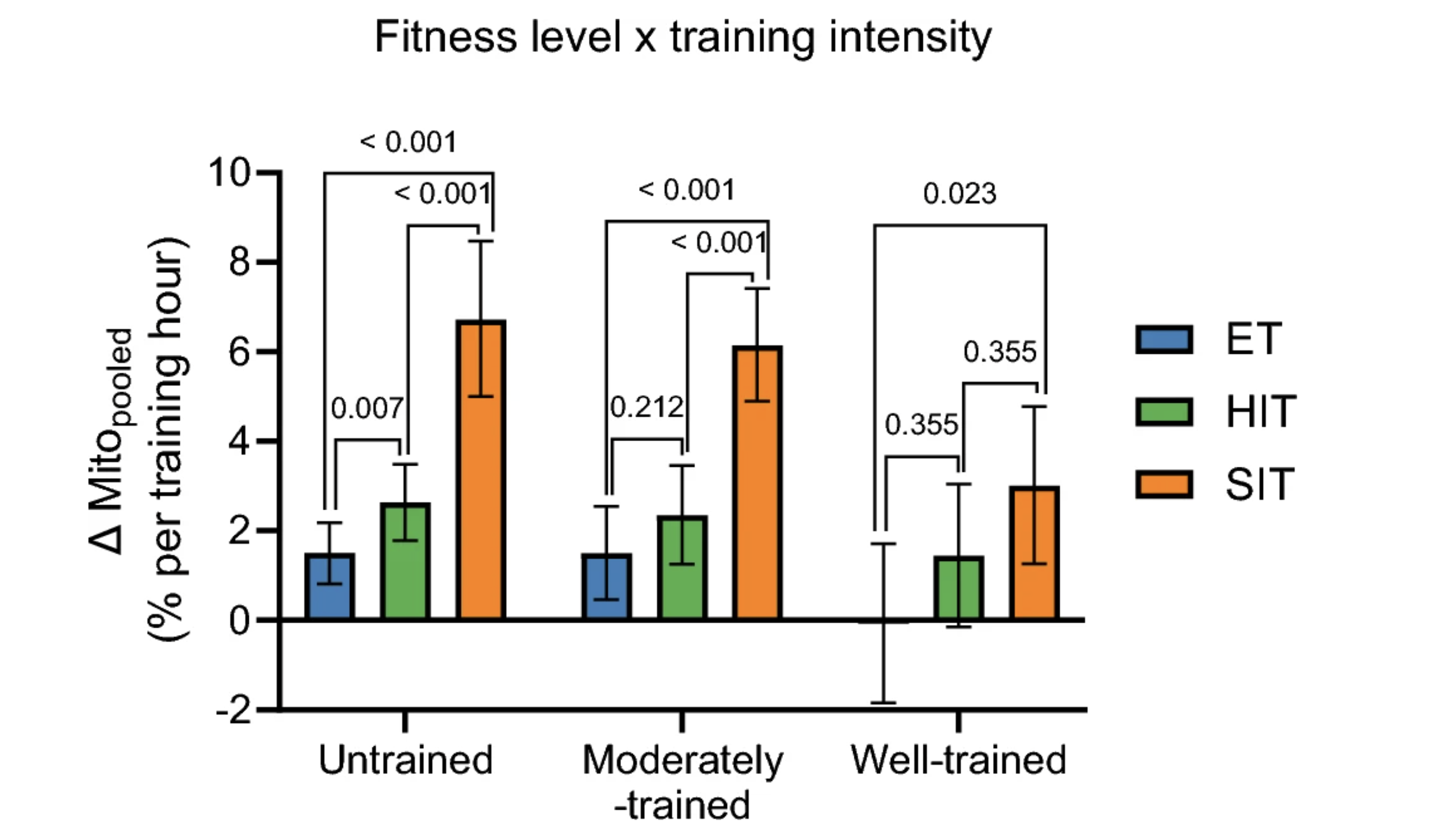
Figure 6. Exercise training efficiency (percentage increase in mitochondrial content per hour) across three fitness levels (untrained, moderately trained, well-trained) and three intensity categories (endurance training, high-intensity training, sprint interval training). Statistically significant differences (p-values) appear above the bars, demonstrating that sprint interval training (SIT) is the most time-efficient modality—particularly in untrained and moderately trained groups—whereas well-trained individuals show minimal gains from endurance or high-intensity training once normalized by training hours.
Why Does This Matter?
This analysis underscores the importance of considering both absolute improvements (overall rise in mitochondrial content) and relative efficiency (how quickly those gains occur). For many people—especially those juggling busy schedules—time efficiency can be a deciding factor when choosing a training plan. Meanwhile, well-trained athletes often need to push intensity boundaries through sprint-like efforts to achieve meaningful gains, as their adaptive ceiling is already quite high. Thus, whether you’re a recreational exerciser or an elite athlete, understanding these nuances can help shape more informed training strategies that fit your goals, schedule, and baseline level of fitness.
Training Variables and Capillarization
Capillaries are the final interface between the bloodstream and muscle cells, making capillarization—the density of capillaries surrounding each muscle fiber—a critical determinant of how effectively oxygen and nutrients reach the tissues during exercise. This vascular network also helps clear metabolic byproducts like carbon dioxide (CO₂) and lactate. As a result, a well-developed capillary bed underpins both endurance performance and metabolic health by maintaining efficient oxygen delivery and waste removal over prolonged activity.
Key Findings
- Training Modalities: Each intervention category (endurance, high-intensity, and sprint interval training) led to meaningful increases in the capillary-to-fiber ratio, implying that any structured exercise can prompt some degree of angiogenesis—the growth of new blood vessels. However, capillary density (capillaries per unit area of muscle) rose significantly only with endurance and high-intensity training. This discrepancy suggests that shorter, more explosive sprint workouts may not consistently generate the same sustained shear stress or metabolic demands that foster robust vascular remodeling.
- Endurance Training Dominates: Notably, endurance training produced the largest gains in capillary density, surpassing high-intensity and sprint interval approaches by an additional 5–10% (panels A and B). This advantage could reflect the longer cumulative duration of exercise at submaximal intensities, which elevates blood flow for extended periods. Over time, increased shear stress on the vascular endothelium—and the consequent release of growth factors like vascular endothelial growth factor (VEGF)—drives more pronounced angiogenesis.
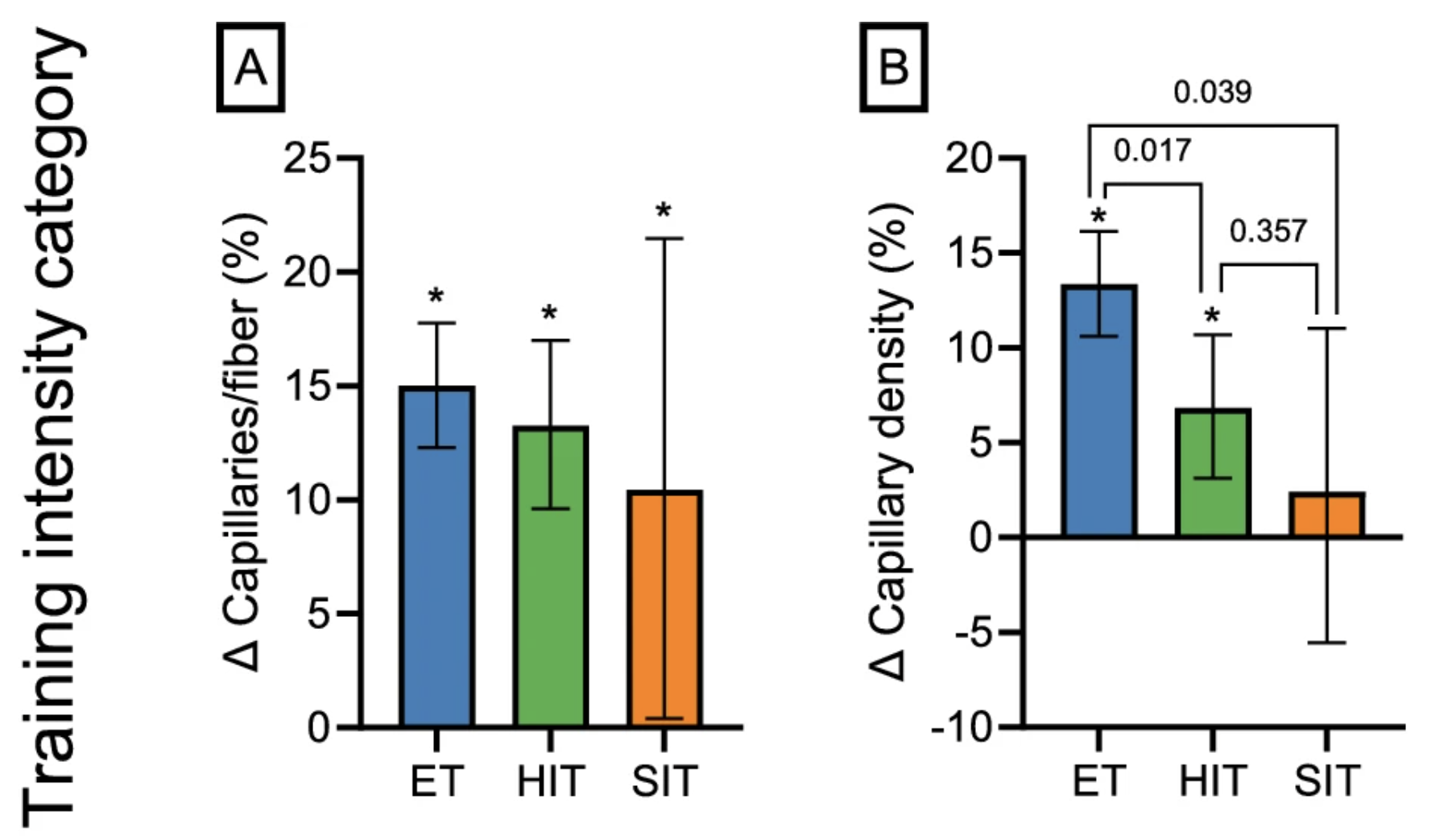
Influence of Baseline Fitness
1. Untrained and Moderately Trained Individuals. Showed 10–20% increases in both capillary-to-fiber ratio and capillary density (panels D and E), highlighting the broad adaptive potential in those who have yet to approach their physiological ceiling. Because their baseline vascular networks are typically less developed, these individuals can experience larger relative gains from almost any consistent exercise stimulus.
2. Well-Trained Individuals. Demonstrated no additional improvements in capillarization across the interventions—a clear example of the principle of diminishing returns. Once an athlete’s vascular capacity is already high, novel or more intense stimuli may be needed to elicit further angiogenic responses. This phenomenon underscores the need for targeted and possibly periodized training in advanced athletes looking to improve, or at least maintain, already robust capillary networks.
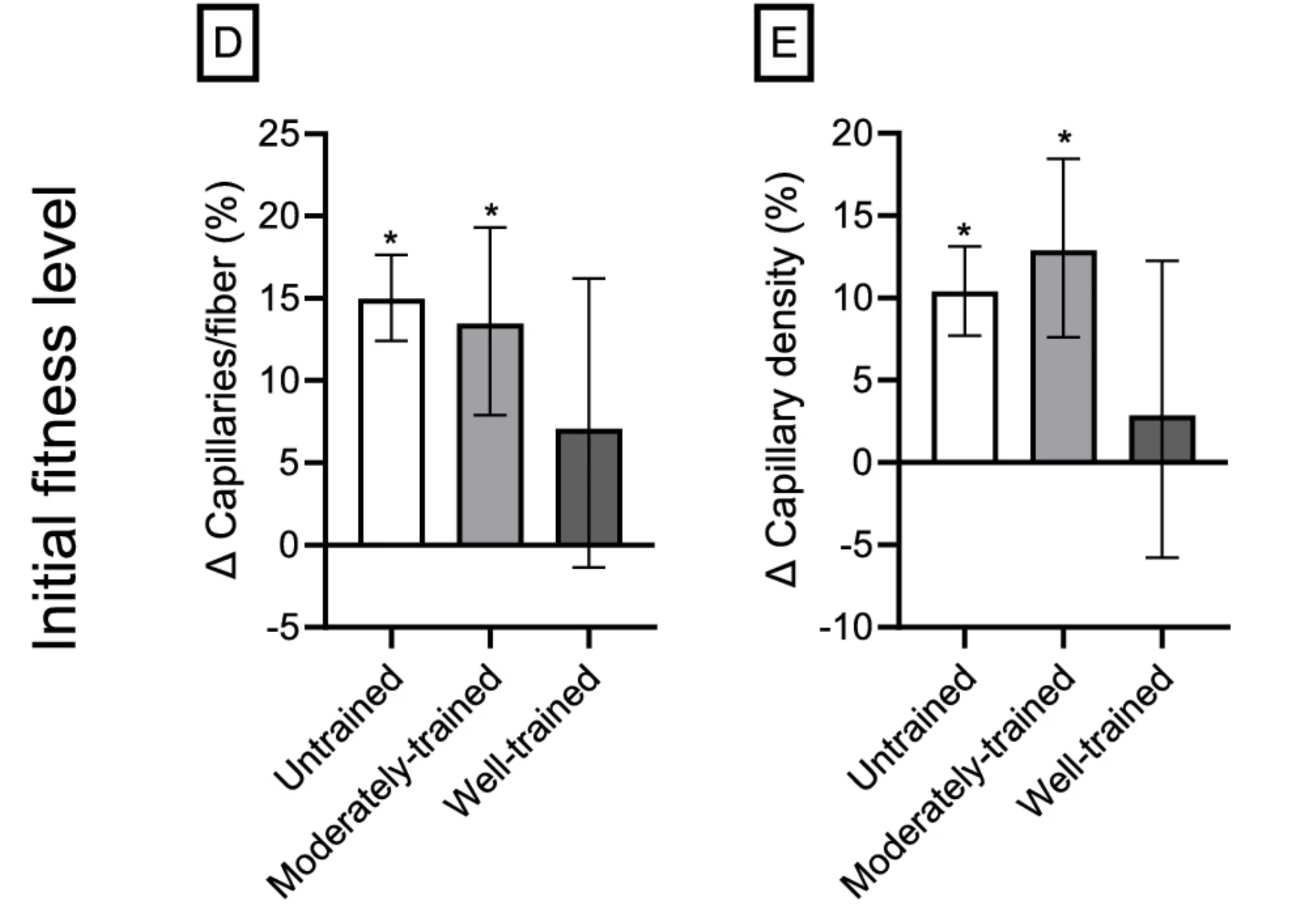
Physiological Underpinnings of Capillary Adaptation Findings
- Shear Stress and Endothelial Cell Activation. The repeated, moderate load of endurance exercise elevates blood flow, creating shear stress on the vessel walls. This mechanical force stimulates endothelial cells to upregulate angiogenic factors (e.g., VEGF), sparking the growth of new capillaries.
- Metabolic Demand and Hypoxia. During exercise, local muscle hypoxia (low oxygen) and accumulation of metabolic byproducts can also signal capillary proliferation. Endurance-oriented workouts, with their extended duration, often maintain these signals long enough to reinforce angiogenic processes.
- Training Specificity. While high-intensity workouts can induce angiogenesis, they often rely more on anaerobic pathways and rapid fluctuations in oxygen demand. By contrast, submaximal efforts consistently stress the aerobic metabolism and may provide a more stable stimulus for the vascular system over the course of a training session.
Timeline for Capillary Changes
Interestingly, capillarization appeared to improve within four weeks of starting a training program, suggesting a relatively rapid remodeling of the vascular network. However, extending training beyond this duration did not yield additional increases. This could imply that the initial phase of consistent exercise triggers most of the vascular remodeling, and subsequent training might need to be further varied or intensified to maintain the stimulus for continued capillary development.
Takeaways
- More Than Just Perfusion: A robust capillary network enhances not only oxygen delivery but also nutrient exchange, hormone signaling, and waste removal, contributing to faster recovery and sustained endurance over time.
- Adaptation Depends on Baseline: Beginners and moderately fit individuals see the largest relative improvements in capillarization—a crucial factor for building aerobic capacity—whereas well-trained athletes may need specialized protocols (e.g., longer-duration low-intensity work or carefully designed high-intensity sessions) to further refine their vascular capacity.
Training Variables and VO₂ max
Increases in VO₂ max—the maximal rate of oxygen consumption—are a cornerstone of improved aerobic performance and cardiovascular health. According to the review, all training modalities produced notable gains in VO₂ max:
- Endurance training: +10%
- High-intensity training: +12%
- Sprint interval training: +9%
These increases were statistically indistinguishable, suggesting that when total training volume and duration are considered, multiple paths can lead to similar top-line improvements in aerobic capacity.
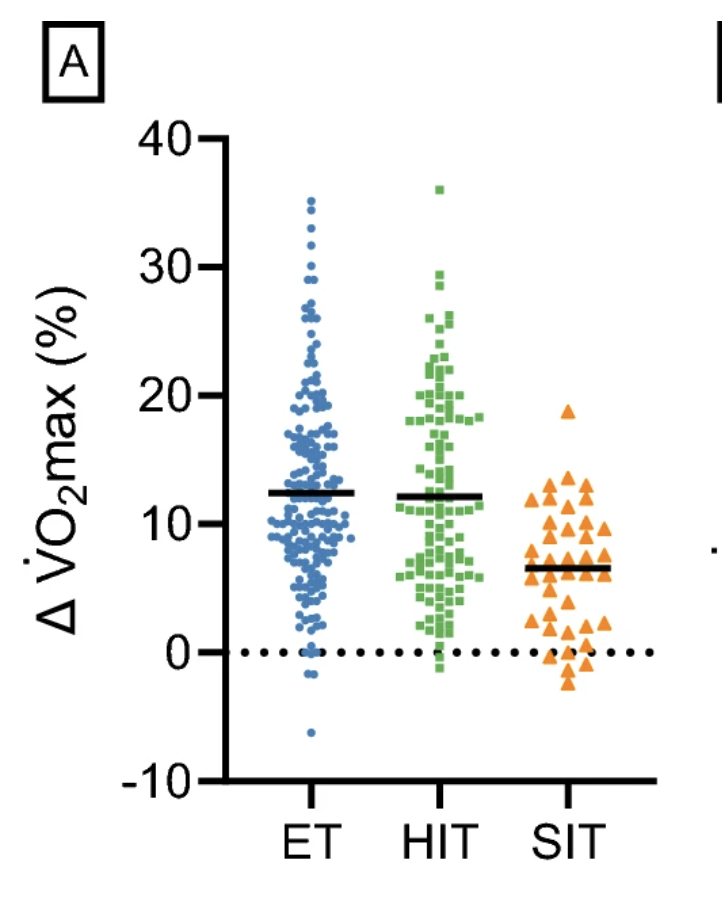
Timeline of Adaptations
Mirroring the patterns seen with mitochondrial content, VO₂ max began to rise within the first two weeks of a new training program:
- Endurance training: +3.6%
- High-intensity training: +7%
- Sprint interval training: +8%
Subsequent phases (2–6 weeks and 6–10 weeks) brought continued gains, particularly with endurance and high-intensity protocols. Notably, endurance training showed consistent and long-lasting improvements, extending up to 25 weeks. This enduring effect highlights how repeated aerobic sessions can produce incremental benefits over prolonged periods, potentially reflecting the steady reinforcement of both cardiovascular (e.g., stroke volume, blood volume) and muscular (e.g., oxidative enzyme capacity) adaptations.
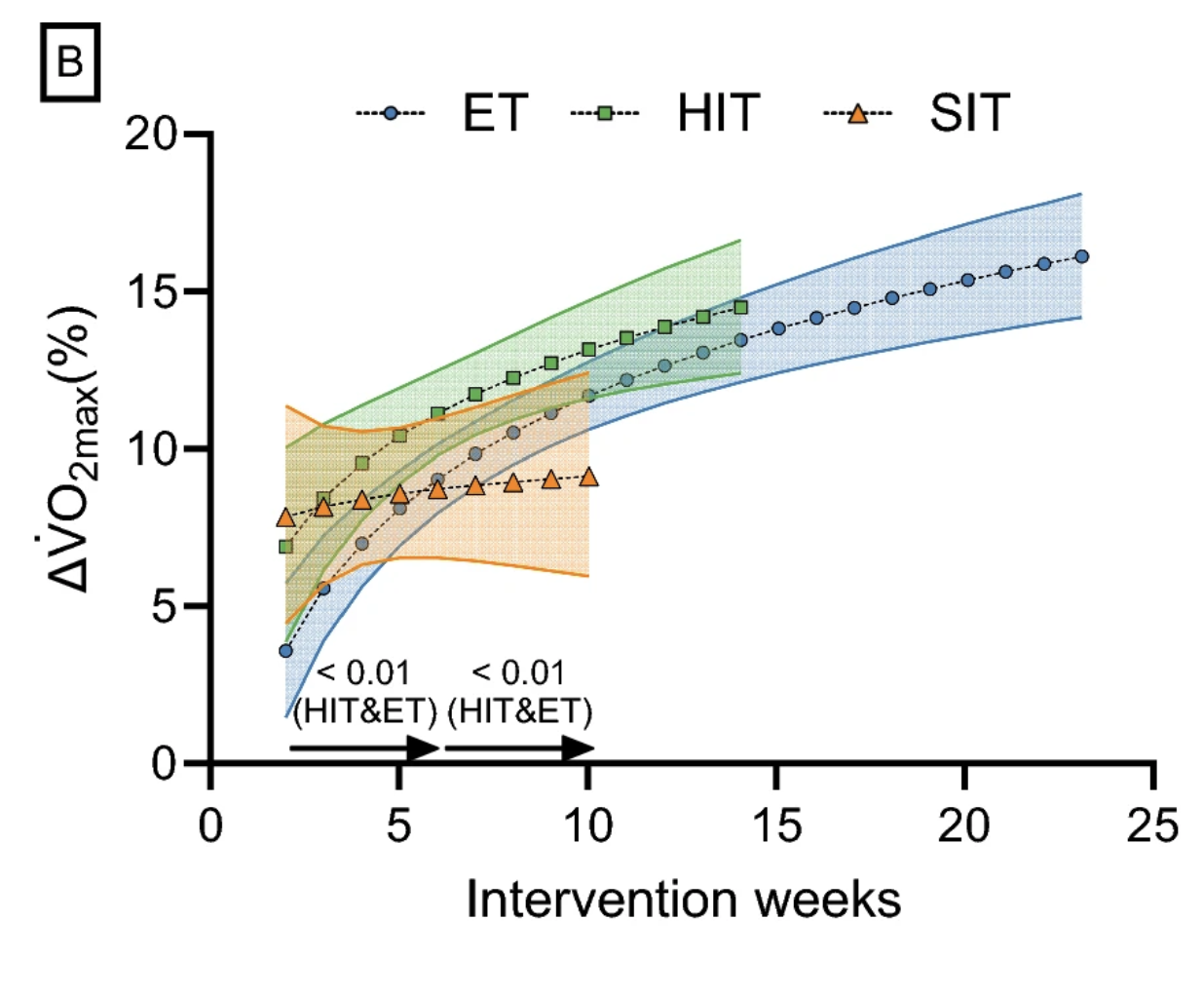
Panel B: Time course of VO₂ max improvements across 25 weeks of endurance training (ET), high-intensity training (HIT), and sprint interval training (SIT). Each curve represents the modeled average change in VO₂ max (as a percentage above baseline), with shaded regions indicating confidence intervals. Significant differences between HIT and ET (p < 0.01) occurred during the early (weeks 0–5) and mid (weeks 5–10) phases of training, underscoring distinct adaptation profiles over time.
Training Frequency
Another key factor influencing VO₂ max gains was training frequency. Participants who exercised six times per week made the largest gains, followed by those training four times per week, then two times per week. From a physiological standpoint, more frequent sessions likely maintain higher weekly training loads and more consistent cardiorespiratory and muscular stimuli, thereby accelerating adaptations in oxygen transport and usage.
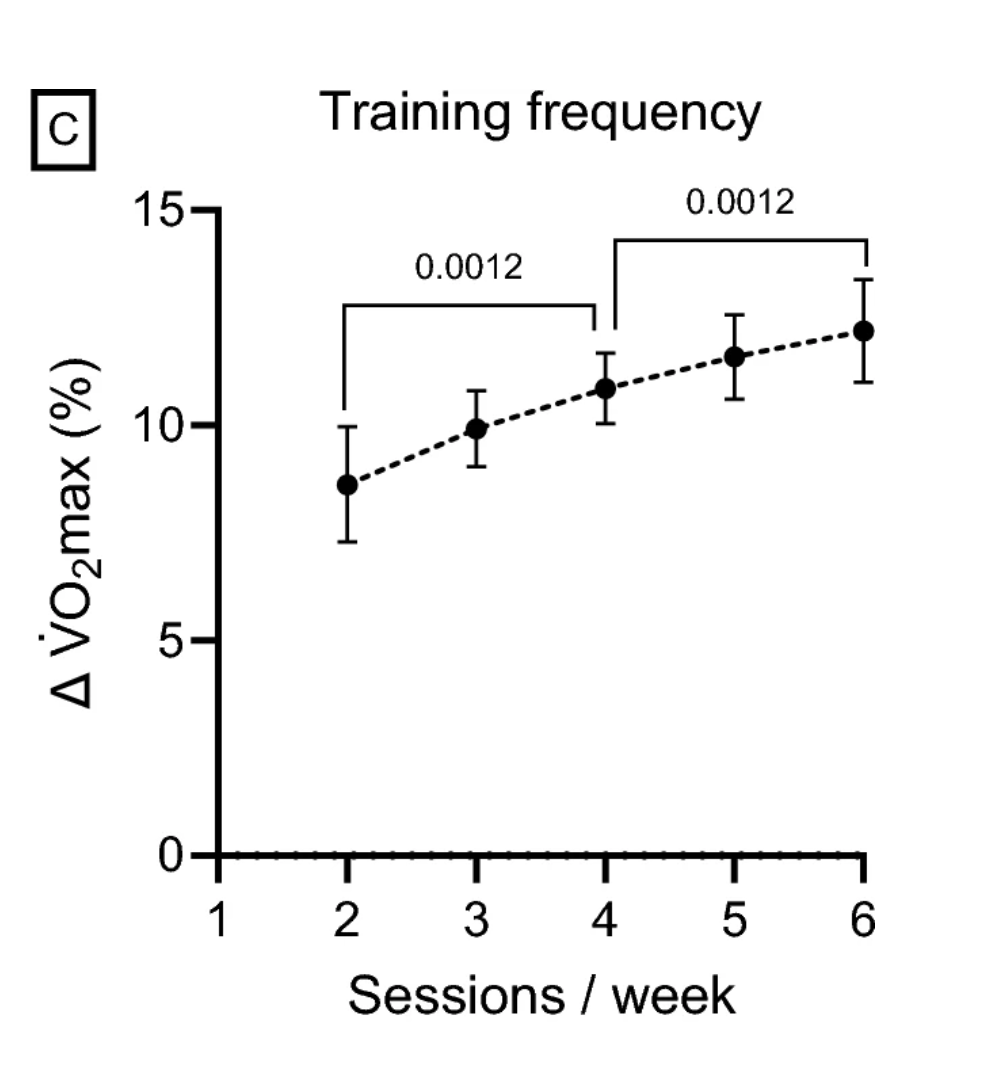
Panel C: Effect of weekly training frequency on VO₂ max improvements. Data points represent mean changes in VO₂ max (%) across different session counts per week, showing a clear trend of greater gains with more frequent exercise.
Influence of Initial Fitness Level on VO2 Max Adaptations
Similar to the patterns seen with mitochondrial content, all fitness levels improved their VO₂ max, but the magnitude of gains showed a familiar “diminishing returns” effect:
- Untrained participants saw an additional 3–8% increase compared to moderately trained or well-trained individuals.
- Moderately trained participants had about 3.7% higher gains than well-trained participants.
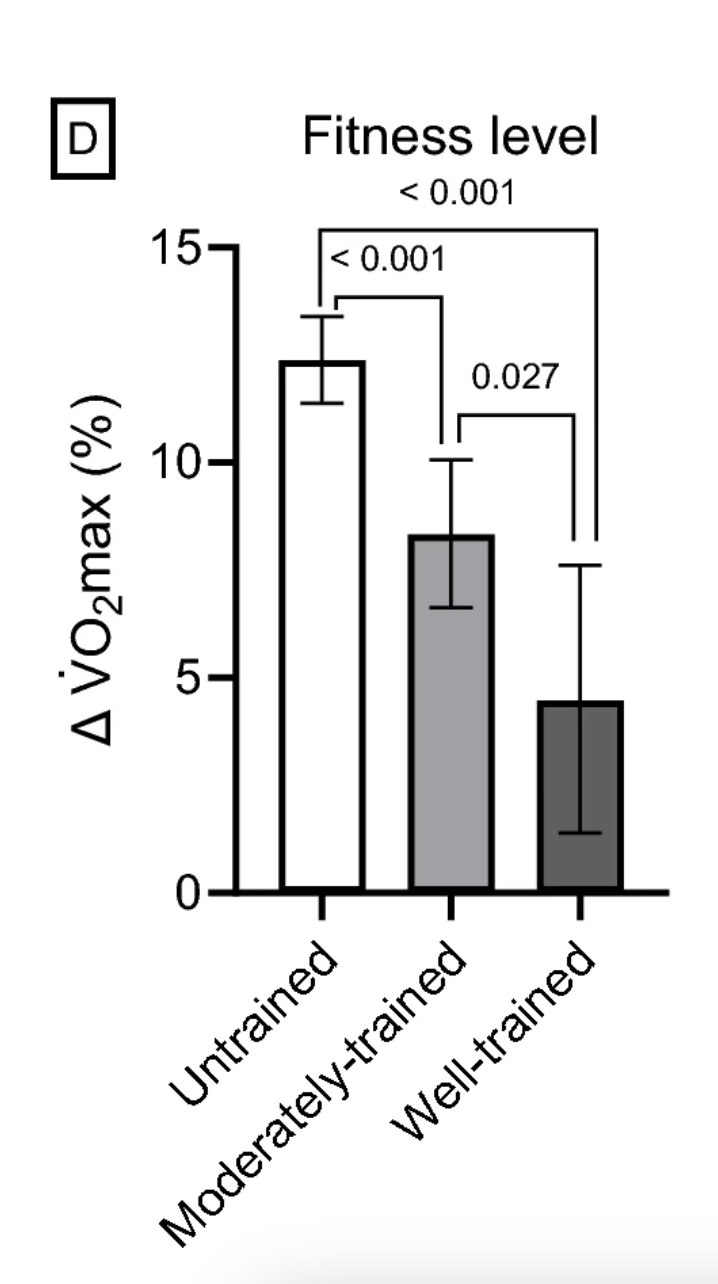
Panel D. Effect of baseline fitness level on VO₂ max improvements. Bars show the mean percentage increase in VO₂ max for untrained, moderately trained, and well-trained participants, with higher gains observed in those starting with lower fitness levels.
These results reinforce the notion that individuals at lower starting fitness tend to reap the most dramatic relative improvements, whereas well-trained athletes may need more specialized or intense programs to achieve incremental VO₂ max gains.
Influence of Age and Sex
- Age: Participants younger than 35 improved by 4.8 mL·kg⁻¹·min⁻¹, those 35–55 increased by 2.9 mL·kg⁻¹·min⁻¹, and those older than 55 improved by 2.2 mL·kg⁻¹·min⁻¹ (panel G). This pattern may reflect age-related differences in cardiac output, muscle mass, and recovery capacity. Still, even older individuals benefited significantly from regular aerobic training.

Panel G. Effect of age group on VO₂ max improvements. Bars show the mean percentage increase in VO₂ max for participants younger than 35, those 35–55, and those older than 55. While younger individuals exhibit a slight trend toward larger gains, the p-values (0.067, 0.813) indicate that differences among age groups did not reach statistical significance.
- Sex: Interestingly, women experienced about 3% greater increases in VO₂ max than men (panel F). While the underlying mechanisms weren’t fully detailed in this review, prior studies suggest that factors such as baseline blood volume, muscle oxidative capacity, and hormonal influences could contribute.
Training Efficiency and Relationships Among V02 Max Adaptations
Why Consider Training Efficiency?
Many studies report absolute changes in VO₂ max or mitochondrial content without accounting for the actual time spent exercising. Yet, for both athletes and recreational exercisers, understanding how quickly these adaptations occur can be just as critical as their overall magnitude. Training efficiency quantifies improvements (e.g., gains in VO₂ max) per hour of exercise, providing a practical measure of how much benefit you get for each minute spent working out.
Sprint Interval Training (SIT) Dominates Minute-for-Minute
When VO₂ max changes were normalized to total training hours, sprint interval training (SIT) again emerged as the most efficient method—about 2.9 times more efficient than high-intensity training (HIT) and ~5 times more efficient than endurance training (ET).
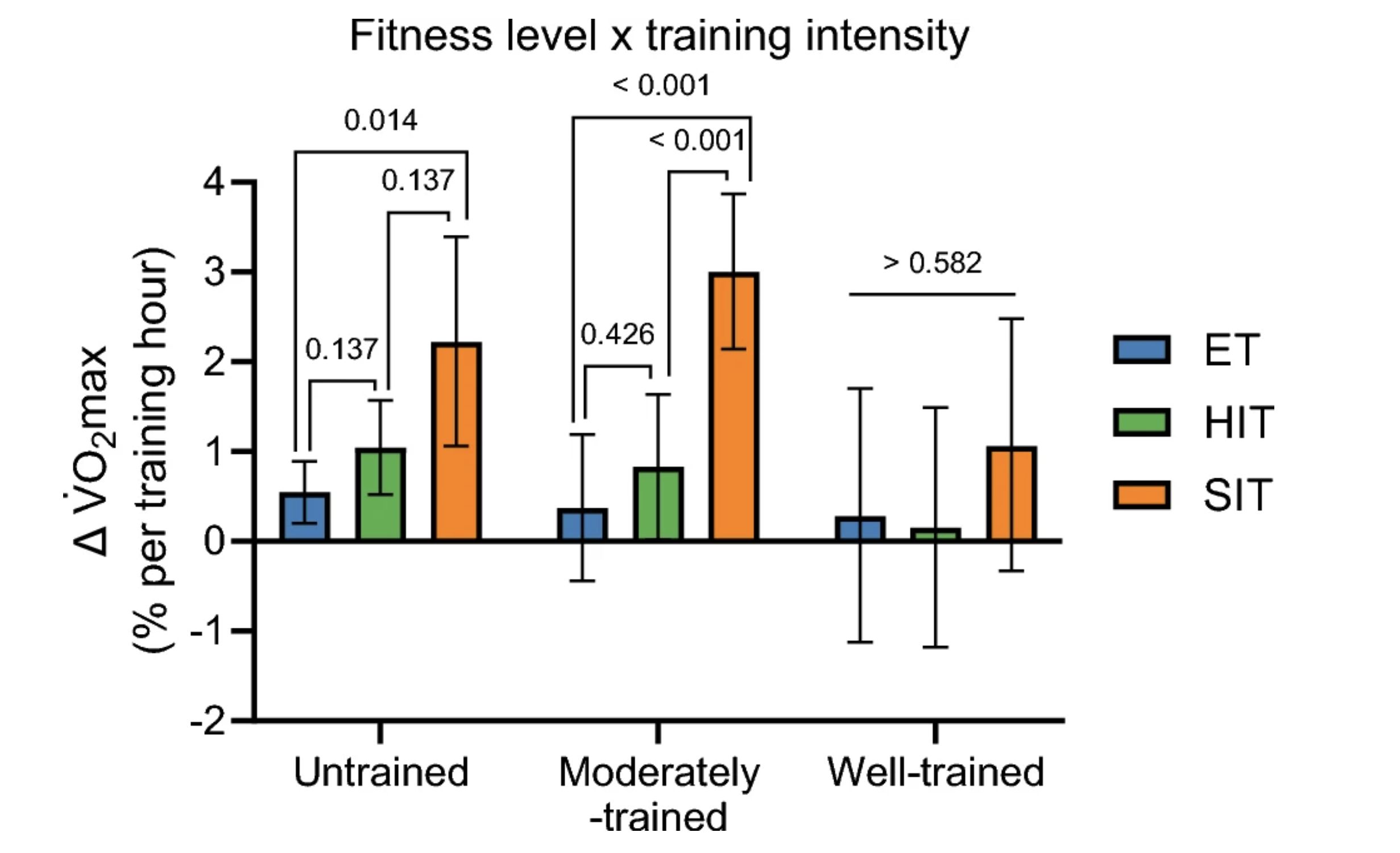
Figure. Effect of training intensity on VO₂ max gains (per training hour) across different fitness levels. Bars show the mean percentage improvement in VO₂ max normalized by total training time, with untrained and moderately trained individuals benefiting most—particularly from sprint interval training (SIT)—and well-trained participants showing minimal per-hour gains.
From a physiological standpoint:
- High-Threshold Fiber Recruitment: SIT involves near-maximal or supramaximal efforts, demanding that the body recruit high-threshold, fast-twitch muscle fibers (type II), which are typically not as engaged during moderate-intensity endurance sessions. The intense metabolic stress in these fibers signals robust aerobic and anaerobic adaptations, driving rapid VO₂ max improvements.
- Metabolic and Cardiovascular Stress: Brief, all-out intervals provoke large swings in heart rate, stroke volume, and oxygen extraction, forcing the cardiovascular system to operate near its upper capacity. Repeated exposure to such extremes can accelerate central (cardiac) and peripheral (muscular) adaptations, enhancing VO₂ max in fewer total training minutes.
- Signaling Pathways: The extreme energetic demands of SIT—often manifested as high lactate accumulation—activate key transcription factors (e.g., PGC-1α), stimulating mitochondrial biogenesis and improved oxidative capacity. The short, explosive bouts also produce potent neuromuscular adaptations that can further contribute to overall cardiorespiratory fitness gains.
Influence of Fitness Level on Training Efficiency
Untrained and moderately trained individuals possess a broad adaptive capacity, meaning they can significantly improve from almost any structured exercise regimen. When gains were normalized per hour of training, both sprint interval training (SIT), high-intensity training (HIT), and endurance training (ET) yielded notable VO₂ max improvements in these groups. Because their systems are relatively “unconditioned,” short, intense workout sessions can provide a powerful stimulus for cardiovascular and metabolic adaptations, resulting in substantial efficiency gains.
By contrast, well-trained individuals did not experience an increase in VO₂ max per hour of training with any modality except SIT. This underscores the principle of diminishing returns: as athletes get closer to their performance ceiling, more specialized or intense stimuli are required for further improvements. Although higher volumes of lower- or moderate-intensity work may help maintain conditioning, they do not necessarily boost VO₂ max on a “per hour” basis once an advanced level of fitness has been reached. Notably, the maximal effort nature of SIT seems to offer a unique enough challenge to nudge VO₂ max upward, even among those who might otherwise plateau.
Correlations Among Mitochondrial Content, VO₂ max, and Capillarization
A key finding in this review was the parallel growth among mitochondrial content, VO₂ max, and capillarization. Participants who experienced larger gains in mitochondrial density also tended to show substantial increases in VO₂ max. From a physiological standpoint, this linkage is highly intuitive:
- Mitochondrial Content: The more mitochondria a muscle fiber contains, the greater its capacity to produce ATP via oxidative phosphorylation. By extension, improved mitochondrial density enables muscles to sustain higher workloads for longer before shifting to anaerobic metabolism.
- VO₂ max: Often viewed as the “ceiling” of aerobic capacity, VO₂ max encapsulates central factors like cardiac output and peripheral factors such as mitochondrial oxidative capacity. When muscle cells can use oxygen more efficiently (thanks to an expanded mitochondrial network), the body’s overall aerobic “ceiling” tends to rise, elevating VO₂ max.
- Capillarization: Increasing the number of capillaries per muscle fiber (or per unit area) ensures a more consistent and efficient delivery of oxygen and nutrients, while also facilitating the removal of metabolic byproducts (e.g., CO₂, lactate). A denser capillary bed can thus enhance the muscles’ effective use of newly acquired mitochondrial capacity.
Synergy of Adaptations
When both mitochondrial content and capillarization grow in tandem, the result is a potent synergy:
- Enhanced Oxygen Utilization: More capillaries deliver oxygen at a higher rate, and abundant mitochondria extract and convert that oxygen into ATP more efficiently.
- Improved Metabolic Buffering: Better blood flow also accelerates the clearance of lactate and other byproducts, postponing fatigue.
- Greater Endurance and Performance: Overall, these interlinked changes foster more robust and sustained aerobic outputs, as evidenced by the parallel increase in VO₂ max.
This trio of adaptations underscores that aerobic fitness isn’t just about how hard the heart can pump blood or how many mitochondria you have individually—it’s about coordinated growth in your body’s oxygen transport (capillaries), utilization (mitochondria), and overall maximal capacity (VO₂ max). By emphasizing any single factor at the expense of the others, potential gains in aerobic performance and metabolic health may be constrained. Conversely, strategies that address both mitochondrial and vascular development can elicit meaningful, long-term improvements in cardiorespiratory fitness.
A quick recap of the study's findings:
1. Training Volume and Intensity Drive Mitochondrial and VO₂ max Gains
The analysis highlights that larger training volumes (e.g., higher weekly session frequency or a greater overall duration of the intervention) lead to more pronounced increases in both mitochondrial content and VO₂ max. At the same time, when normalized per hour of exercise, sprint interval training (SIT) emerged as the most efficient modality, followed by high-intensity training (HIT), and then endurance training (ET). These results underscore a classic principle in exercise physiology: more total time under load generally begets stronger adaptations, yet high-intensity or supramaximal efforts can achieve similar or greater gains in a fraction of the time—at least initially.
2. Rapid Early Gains from SIT, Sustainable Growth from ET and HIT
The data suggest that SIT provides quick, robust improvements in mitochondrial content and VO₂ max within the early stages of a training program—often within the first 2–4 weeks. In contrast, endurance training and high-intensity training demonstrate a more gradual but steady trajectory of improvement over a longer period. This finding supports the idea of progressive, ongoing adaptation from moderate and high-intensity continuous efforts, whereas SIT capitalizes on potent but time-limited signals that can plateau if volume remains low or if stimulus variability is lacking.
3. Capillarization Occurs Early and Favors Lower Fitness Levels
Gains in capillarization (i.e., the density and number of capillaries per muscle fiber) appear predominantly within the first <4 weeks of training. Moreover, these vascular adaptations were significant only in untrained to moderately trained participants, indicating a point of diminishing returns for well-trained individuals who may already possess a high degree of vascularization. While capillaries per fiber (CF) increased similarly across ET, HIT, and SIT, capillaries per mm² fiber area (CD) rose only with ET and HIT, with ET producing the most substantial increases. This distinction underlines that longer, moderate-intensity sessions tend to be particularly effective at nurturing vascular remodeling.
Implications for Training Programs
The analysis consistently points to the principle that a larger overall training volume—the product of intensity and duration—leads to greater increases in both mitochondrial content and VO₂ max. In practice, this means that exercising more frequently per week or extending the length of your sessions can stimulate more robust aerobic adaptations. However, the data also reveal that:
When time is limited, higher-intensity training can serve as a short-term “substitute” for large training volumes.
In other words, if you can’t commit to lengthy or frequent workouts, high-intensity protocols can deliver meaningful gains in mitochondrial function and cardiorespiratory fitness—particularly during the initial weeks of a new program. As the authors point out, sprint interval training (SIT) tends to drive quick and efficient improvements in mitochondrial content within the first 2–4 weeks. Beyond that initial phase, though, you may see diminishing returns if you continue with a low overall volume.
From a physiological standpoint, this outcome makes sense:
- High-intensity efforts expose muscles to acute bouts of high metabolic demand, upregulating key signaling pathways such as PGC-1α, which promotes mitochondrial biogenesis.
- Over time, maintaining or pushing further adaptations generally requires increasing training volume—either by adding more sessions, extending session length, or introducing additional stimuli like endurance work.
Balancing High-Intensity and Endurance Training
So how do we reconcile these seemingly different approaches? The most sustainable and comprehensive gains in mitochondrial content and VO₂ max tend to come from both moderate- and high-intensity work.
- High-intensity intervals are efficient for rapid improvements in aerobic capacity and metabolic function.
- Lower-intensity endurance training helps extend and solidify these adaptations over the long haul.
Moreover, the vascular system has its own specific demands. Capillarization responds best to low-to-moderate intensity, high-volume training. This adaptation is central to overall blood vessel health and more efficient oxygen delivery during prolonged exercise. Consequently, a heavy reliance on purely high-intensity intervals might leave vascular adaptations underdeveloped, especially over the long term.
Why Lower-Intensity Training Still Matters
The benefits of lower-intensity (endurance) training go beyond simple “base building.” By prioritizing the capillary network, this approach ensures ample blood flow and nutrient supply to the muscles, which supports recovery, metabolic health, and the potential for further aerobic gains. For many individuals—ranging from health enthusiasts to endurance athletes—capillary density can be just as important as VO₂ max for overall performance, fatigue resistance, and long-term cardiovascular health.
Key takeaway: While short bursts of high-intensity work can jump-start mitochondrial and VO₂ max improvements, your program needs steady, sustained aerobic work to reinforce and maintain these gains, foster robust vascular adaptations, and promote lasting health benefits. A strategic blend of intensities—ideally tailored to your fitness level, time constraints, and long-term goals—offers the surest path to maximizing both performance and well-being.
Recognize Individual Baseline Fitness and Training Status
A key takeaway is that your baseline training status heavily shapes how you respond to any given exercise protocol. “Training load”—the overall physiological stress imposed by exercise—can vary dramatically between individuals performing the same workout. A 30-minute high-intensity session, for instance, might push one person to the brink of exhaustion while remaining moderate for another with a higher aerobic capacity. Similarly, a 90-minute “zone 2” ride may be barely stimulating for someone highly trained but extremely taxing for a newcomer.
This variability highlights the limitations of blanket prescriptions like “everyone needs X hours of endurance training each week” or “high-intensity workouts should be 20% of your total training.” Such guidance can be too generic, failing to account for an individual’s fitness level, recovery ability, or specific goals.
Leverage Training Efficiency and Intensity Dependencies
The study’s results confirm that high-intensity modalities, such as sprint interval training (SIT), yield rapid mitochondrial improvements but may plateau relatively quickly. This efficiency makes them excellent for time-crunched individuals looking for a fast boost in aerobic fitness. However, endurance training (ET) and high-intensity interval training (HIT) can lead to more sustained adaptations when extended over longer periods.
An effective approach might involve alternating between short, intense intervals to ignite quick gains and longer, moderate sessions to consolidate and extend those improvements over time. This blend capitalizes on the efficiency of sprints while ensuring steady, continuing adaptation.
Revisiting “Intensity vs. Volume”
A long-running debate in exercise physiology questions whether total training volume (time spent exercising) or intensity is more important for outcomes like mitochondrial biogenesis. This comprehensive meta-analysis suggests a synergistic view:
- Intensity is powerful within a given volume—SIT can yield outsized gains in a short window.
- Volume fosters sustained improvements, ensuring that initial gains in mitochondrial function and VO₂ max do not stall prematurely.
Age Is Less of a Limiting Factor Than You May Think
Contrary to the notion that aerobic capacity or mitochondrial function becomes difficult to improve in older adults, this research demonstrates that meaningful gains in mitochondrial content, capillarization, and VO₂ max are achievable at any age—provided the training load is sufficient. Age-related declines in performance are real, but regular exercise can significantly offset them.
The initial fitness level emerges as the most influential factor in determining overall adaptation. Whether you’re 25 or 65, if you’re starting at a lower baseline, expect larger relative gains as you build up your aerobic engine.
Real-World Applications and Case Examples
Translating these findings into everyday life starts with identifying your primary goals, time constraints, and current fitness level. The research suggests that sprint interval training (SIT) can deliver quick improvements in mitochondrial function and VO₂ max, making it appealing for time-crunched individuals. On the other hand, endurance and high-intensity training (HIT) promote more sustained adaptations over longer periods and may better support vascular health. Here are some scenarios to illustrate how you might blend these approaches:
- Busy Parent or Full-Time Professional For someone juggling a hectic schedule, time efficiency can be the deciding factor. Incorporating one or two weekly SIT sessions, each consisting of short sprints (15–60 seconds) with ample recovery, can spark significant gains in aerobic capacity and metabolic function. You might then add one or two moderate-intensity sessions, such as a 30-minute steady run or brisk walk, to bolster vascular adaptations and endurance. This balanced approach nurtures both rapid fitness improvements and longer-term cardiovascular benefits—without demanding hours every day.
- Active Older Adult or Master’s Athlete: Those with a more established fitness base but facing age-related changes could maintain or even enhance VO₂ max by focusing on a slightly higher volume of moderate-intensity training to support capillarization and overall cardiovascular health. Regular low- to moderate-intensity efforts (e.g., a 45–60 minute session 3–4 times per week) can help sustain capillary growth and maintain a robust aerobic engine. Occasional interval or sprint sessions (once a week or once every two weeks) may add variety, prevent plateaus, and provide a sharper stimulus for mitochondrial adaptations—helping you retain top-end performance without undue joint or recovery strain.
- Competitive Endurance Athlete: Athletes aiming for longer events, like marathons or triathlons, often need a significant volume of endurance work to reinforce muscle capillarization, improve fat metabolism, and boost fatigue resistance. However, high-intensity intervals can still play an essential role, especially during a build phase or when seeking to push VO₂ max higher. A typical regimen might involve two to three moderate-volume days each week, interspersed with one or two targeted interval workouts—all carefully periodized to manage fatigue and prevent overtraining.
- Fitness Enthusiast Seeking Overall Health: For those without a specific performance goal, a rotating schedule that incorporates varied intensities can keep workouts both effective and engaging. You might enjoy group fitness classes (often featuring interval-based formats) alongside weekend hikes or longer, steady-paced cycling sessions. This diversity helps sustain motivation, reduces risk of overuse injuries, and ensures broad-spectrum physiological benefits—from metabolic health to cardiovascular function.
Across these examples, the principles stay the same:
- Higher-intensity methods (SIT, HIT) for time efficiency and rapid gains.
- Steady-state endurance training for sustained adaptations, vascular health, and overall aerobic capacity.
- Personalized progression based on your baseline fitness, goals, recovery capacity, and schedule constraints.
No matter the route, the meta-analysis findings highlight that consistency and balance are key. By weaving together the right dose of intensity and volume, you can tailor a routine that fits your lifestyle—whether that means sprint intervals on a busy weekday or longer endurance sessions to build a deeper aerobic base over time.